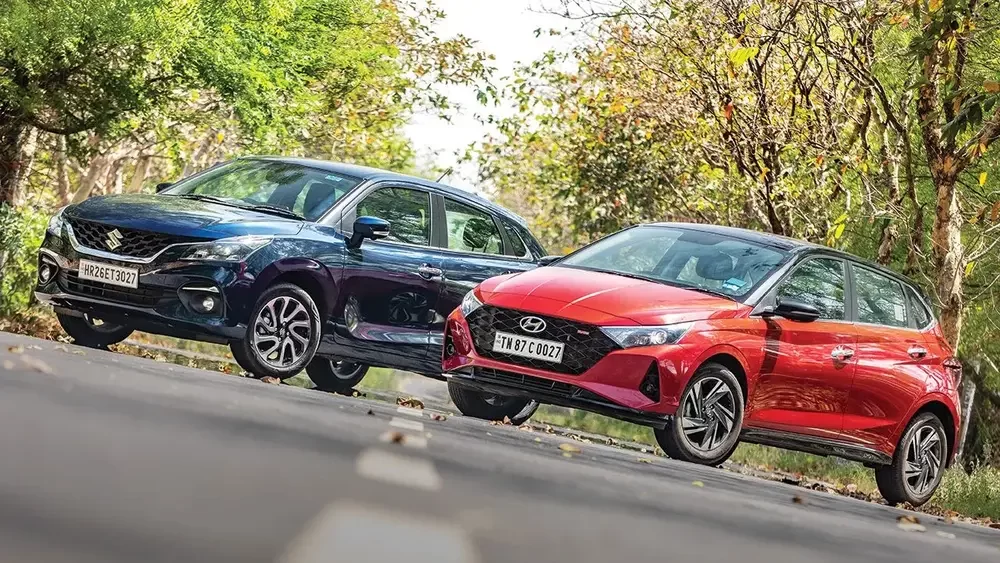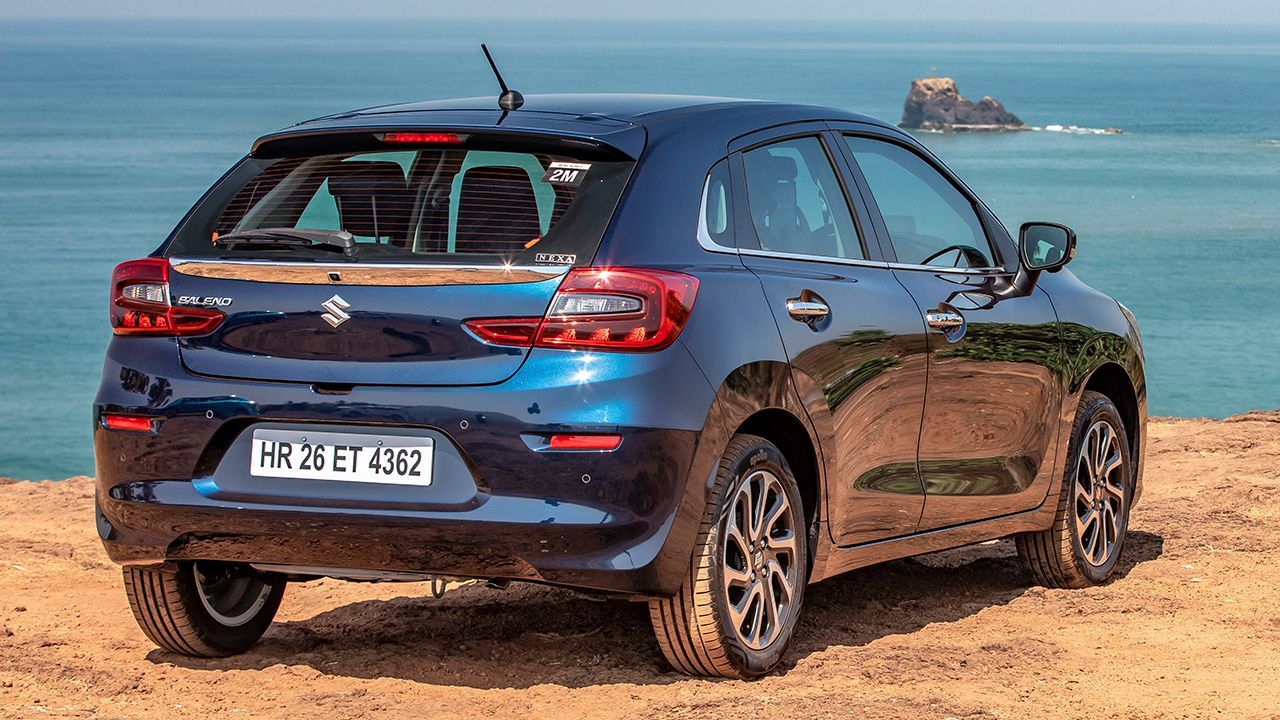These two offerings are old rivals in the hatchback market. Undoubtedly, they are among the bestselling vehicles in the Indian four-wheeler market. Plus, both vehicles are available in petrol, but the Baleno has left no corners, as it also caters to CNG buyers. However, both companies have axed the diesel variants from these two vehicles.
In addition, Maruti Suzuki has wiped out diesel cars from their fleet, while Hyundai India has retained a few diesel offerings. You can check out the fuel-wise Hyundai cars list here.
However, apart from that, let’s see how the Hyundai i20 stacks up against the Maruti Suzuki Baleno, in terms of features and specifications. Let’s read on, then.
Specifications
Before jumping to the figures, let’s talk about the platforms of these two vehicles. As for the Hyundai i20, this hatchback is based on the Hyundai-Kia K2 platform that also underpins several Hyundai and Kia cars, such as the Creta, Alcazar, Venue, Verna (fifth generation), Sonet, Seltos, and Carens (MUV).
On the other hand, the Maruti Suzuki Baleno is based on the Heartect platform that is shared with other Maruti Suzuki cars, such as the Baleno, Ignis, Swift, Dzire, Wagon R, Alto K10, Celerio, and Fronx.
Further, as mentioned earlier, both vehicles are available in petrol. Unlike the Hyundai i20, the Baleno can be had in CNG. Plus, both are powered by a 1.2-litre petrol engine that has more or less the same output.
As for the petrol version of the Baleno, it has a 1.2-litre VVT, four-cylinder, naturally-aspirated mill, which is tuned to churn out 88 bhp at 6000 rpm and 113 Nm of peak torque at 4400 rpm. The CNG version has a lower engine output, delivering a power of 76 bhp at 6000 rpm and a peak torque of 98.5 Nm at 4300 rpm.
The five-speed manual can be coupled with the petrol and CNG versions, while the five-speed AMT is exclusive to the petrol version.
In parallel, the Hyundai i20 is solely powered by a 1.2-litre Kappa, four-cylinder, naturally aspirated, petrol unit with an output of 87 bhp at 6000 rpm and 114.7 Nm of torque at 4400 rpm. It can either be had with a five-speed manual or an IVT unit. There is also a sportier version of the i20, which has a turbo-petrol engine, called the i20 N-Line. You can check out the variant-wise i20 price list here.
In terms of fuel efficiency, the Maruti Suzuki Baleno’s mileage ranges between 22.35 km/l and 30.61 km/kg. On the other hand, the 2023 Hyundai i20’s mileage ranges between 19.8 km/l and 20.8 km/l. That said, the mileage depends on the combination of engine and transmission, local traffic conditions and individuals’ driving styles.
Suspensions, Brakes and Tyres
These two locally manufacturing vehicles are engineered by keeping the conditions of Indian roads in mind. That said, the Maruti Suzuki Baleno stands on a McPherson Strut suspension at the front and torsion beam suspension at the rear. A nearly identical setup is found in the Hyundai i20. That said, it also has a McPherson Strut at the front and a coupled torsion beam axle at the rear.
These suspension setups have proven their capabilities to withstand the Indian roads. They can soak the undulations and bumps from potholes with ease. In addition, you can also check out the comparison between the Maruti Suzuki Baleno and Hyundai i20 here.
Apart from that, the braking duties are taken care of by disc-drum brakes on these two hatchbacks. The disc brakes are at their front ends, while the drum brakes are at their rear ends. The top variants of these two offerings run on alloy rims. Their tyre profiles are also the same, rated at 195/55 R16.
Their Proportions
Beginning with Hyundai i20’s dimensions, it has a length of 3995mm, a width of 1775mm, a height of 1505mm, and a wheelbase of 2580mm. On the other hand, the Maruti Suzuki Baleno is dimensionally smaller than its Korean counterpart. It measures 3990mm in length, 1745mm in width, 1500mm in height, and 2520mm in wheelbase.
Weighing their wheelbase, the Hyundai i20 has a better measurement, as a result, it will offer better legroom than that of the Baleno.
Last, but not least, the Baleno’s boot space is rateing at 318 litres, while the i20’s boot space is rate at 311 litres.
Their Features
Both vehicles possess a good number of features. Let’s start with the Hyundai i20. Please note that the features mentioned here belong to the top variant of these two vehicles. Check out the variant-wise Hyundai i20 price list here.
It boasts a tyre pressure monitoring system, a reverse camera with guidance, artificial leather upholstery, a cooled glove box, and a sunglass holder. Further, it is exclusive to an electrically adjustable single-pane sunroof, ambient lighting, puddle lamps, a fully digital instrument cluster, and a wireless charger. It also has a bigger touchscreen infotainment unit, which is 10.25 inches, alongside a Bose-sourced audio system.
In parallel, the Maruti Suzuki Baleno has an in-house designed 9-inch touchscreen infotainment unit, labelled as SmartPlay Pro+. Apart from that, it has a semi-digital instrument cluster that works in tandem with a heads-up display (HUD). Other standalone offerings include fabric upholstery, a 360-degree camera, and Alexa compatibility.
As for their common offerings, both cars have child-seat anchorages, seat belt warnings, speed-sensing door locks, auto HVAC, auto-dimming IRVM, cruise control, keyless start/stop button, multi-function leather-wrapped steering wheel (with tilt and telescopic adjustments), 12V sockets, etc. Further, both have electric ORVMs, adjustable cluster brightness, voice command, auxiliary and USB ports, and Android Auto and Apple CarPlay.
For lighting, both hatchbacks have LED projector headlamps, LED tail lights, LED DRLs, and LED fog lamps. They also have automatic headlights and a headlight height adjuster.
On the safety front, both cars are equipping with six airbags, traction control, hill-hold control, brake assist, ESP, and ABS with EBD.
Prices and Variants
The Japanese carmaker offers the Baleno in four broad trims: Sigma, Delta, Zeta, and Alpha. It has a total of nine variants. The Maruti Suzuki Baleno’s price starts at Rs 6.61 lakh for the base variant, the Sigma Petrol MT, and goes up to Rs 9.88 lakh for the top variant, the Alpha Petrol AMT.
In parallel, the Hyundai i20 has five broad trims: Era, Magna, Sportz, Asta and Asta (O). It has a total of twelve variants. As for the Hyundai i20 price, it starts at Rs 6.99 lakh for the base variant, the Era Petrol MT, and goes up to Rs 11.16 lakh for the top variant, the Asta (O) IVT DT.
All are ex-showroom prices in Delhi, as of October 2023. Please note that these prices are subject to change without any prior notice to the customer. You can, however, visit the autoX website to access the latest location-based price list for your dream vehicle. For more, visit our website or connect with us on Facebook, Twitter, LinkedIn, Instagram, and YouTube. So, stay tuned!
Read more: Mahindra XUV700 vs Mahindra Scorpio Classic: The Bestselling Indigenous SUVs


